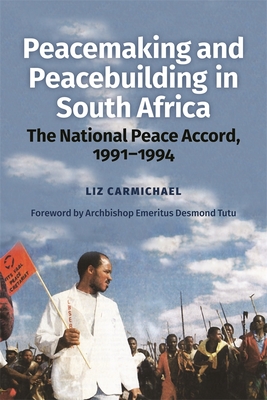Peacemaking and Peacebuilding in South Africa: The National Peace Accord, 1991-1994

Peacemaking and Peacebuilding in South Africa: The National Peace Accord, 1991-1994
This book, written by one of those involved in the process that evolved, provides for the first time an assessment and in-depth account of this key phase of South Africa's history. The National Peace Campaign set up under the NPA mobilized the 'silent majority' and gave peace an unprecedented grassroots identity and legitimacy. The author describes the formulation of the NPA by political representatives, with Church and business facilitators, which ended the political impasse, constituted South Africa's first experience of multi-party negotiations, and made it possible for the constitutional talks (Codesa) to start. She examines the work of the Goldstone Commission, which prefigured the TRC, as well as the role of international observers from the UN, EU, Commonwealth and OAU. Exploring the work of the peace structures set up to implement the Accord - the National Peace Committee and Secretariat, the 11 Regional Peace Committees and 263 Local Peace Committees, and over 18,000 peace monitors - Carmichael provides a uniquely detailed assessment of the NPA, the on-the-ground peacebuilding work and the essential involvement of the people at its heart. Filling a significant gap in modern history, this book will be essential reading for scholars, students and others interested in South Africa's post-Apartheid history, as well as government agencies and NGOs involved in peacemaking globally.
PRP: 736.25 Lei
Acesta este Pretul Recomandat de Producator. Pretul de vanzare al produsului este afisat mai jos.
662.62Lei
662.62Lei
736.25 LeiLivrare in 2-4 saptamani
Descrierea produsului
This book, written by one of those involved in the process that evolved, provides for the first time an assessment and in-depth account of this key phase of South Africa's history. The National Peace Campaign set up under the NPA mobilized the 'silent majority' and gave peace an unprecedented grassroots identity and legitimacy. The author describes the formulation of the NPA by political representatives, with Church and business facilitators, which ended the political impasse, constituted South Africa's first experience of multi-party negotiations, and made it possible for the constitutional talks (Codesa) to start. She examines the work of the Goldstone Commission, which prefigured the TRC, as well as the role of international observers from the UN, EU, Commonwealth and OAU. Exploring the work of the peace structures set up to implement the Accord - the National Peace Committee and Secretariat, the 11 Regional Peace Committees and 263 Local Peace Committees, and over 18,000 peace monitors - Carmichael provides a uniquely detailed assessment of the NPA, the on-the-ground peacebuilding work and the essential involvement of the people at its heart. Filling a significant gap in modern history, this book will be essential reading for scholars, students and others interested in South Africa's post-Apartheid history, as well as government agencies and NGOs involved in peacemaking globally.
Detaliile produsului








